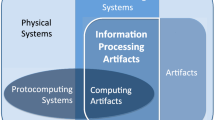Abstract
This article argues how one problem of computing lies in realizing a significant instance given a class or type. Analysis of a case study on digital narrative suggests two general processes for instantiating significant instances: interaction and optimization. The article then explains how the problem of universals needs to be deconstructed when trying to understand what type of entities significant instances are and what the process for obtaining them is.


Similar content being viewed by others
Explore related subjects
Discover the latest articles and news from researchers in related subjects, suggested using machine learning.Notes
Although he raises three types of inference, Peirce did not show how these three are categorized under his universal categories. Two possible categorizations have been proposed so far (Yonemori 1981). The first regards abduction as firstness, since it requires instinctive human ideas, which are categorized as firstness. In this case, deduction and induction are considered secondness and thirdness, respectively. The second categorization regards deduction, induction, and abduction as firstness, secondness, and thirdness, respectively, situating abduction as the highest-level inference. This lack of mention of the universal categories in regards to inference might suggest that Peirce was not so certain about the universal category for inference. Moreover, whether abduction should be included as one of the three most basic types of inference requires examination by considering the possibility of decomposing abductive inference into deduction and induction. I consider instantiation to be another possible candidate as an indispensable means for inference, but Peirce would not agree, since he strictly denied haecceity.
References
Andre, E., Binstead, K., Tanaka-Ishii, K., Luke, S., Herzog, G., & Rist, T. (2000). Three RoboCup simulation league commentator systems. Artificial Intelligence Magazine, Spring(21), 73–85.
Benjamin, W. (1930). The work of art in the age of its technological reproducibility (chapter 1, pp. 19–55). The Belknap Press of Harvard University Press (trans: Jephcott, E., Livingstone, R., Eiland, H., et al., 2008).
Bishop, C. (2006). Pattern recognition and machine learning. New York: Springer-Verlag.
Foucault, M. (2002). Archaeology of knowledge (Part III-4). London: Routledge.
Kitano, H., Asada, M., Kuniyoshi, Y., Noda, I., & Osawa, E. (1995). Robocup: The robot world cup initiative. In First International Conference on Autonomous Agents.
Lonneker, B., Meister, J., Gervas, P., Peinado, F., & Mateas, F. (2005). Story generators: Models and approaches for the generation of literary artefacts. In the 17th Joint International Conference of the Association for Computers and the Humanities and the Association for Literary and Linguistic Computing (pp. 126–133). Victoria, Canada.
MacKenzie, S., & Tanaka-Ishii, K. (Eds.). (2007). Text entry systems—Accessibility, mobility, universality. Morgan Kaufmann (Elsevier). Co-authored chapters 2, 5, 10, 11, 13.
Peirce, C. (1931). Collected papers. Cambridge: Harvard Press.
Propp, V. (1968). Morphology of folktale. Austin: University of Texas Press.
Propp, V. (1984). Theory and history of folklore. Minneapolis: University of Minnesota Press.
Rorty, R. (1979). Philosophy and the mirror of nature. Princeton: Princeton University Press. p. 45.
Tanaka-Ishii, K., Frank, I., & Hasida, K. (2000). Multi-agent explanation strategies in real-time domains. In the 36th Annual Meeting for Association of Computational Linguistics (pp. 158–165).
Tanaka-Ishii, K., & Ishii, Y. (2008). Being and doing as ontological constructs in object-oriented programming. Journal of Applied Semiotics, 20. Web online Journal (forthcoming).
Tanaka-Ishii, K., Noda, I., Frank, I., Nakashima, H., Hasida, K., & Matsubara, H. (1998). MIKE: An automatic commentary system for soccer—System design and control. In International Conference on Multi-Agent Systems (pp. 285–292). IEEE Computer Society.
Ungar, D., & Smith, R. (1987). Self: The power of simplicity, Conference on Object-Oriented Programming, Systems, and Applications (pp. 227–242). Orlando, FL.
Xu, S., Lau, C., Cheung, W. K., & Pan, Y. (2005). Automatic generation of artistic Chinese calligraphy. Journal of Intelligent Systems, 20, 32–39.
Yamanouchi, S. (2008). The problem of universals—as the source of modernism. Heibonsha Library.
Yonemori, Y. (1981). Semiotics of Peirce (p. 62). Tokyo: Keiso Shobo (in Japanese).
Author information
Authors and Affiliations
Corresponding author
Rights and permissions
About this article
Cite this article
Tanaka-Ishii, K. An Instance vs. The Instance. Minds & Machines 19, 117–128 (2009). https://doi.org/10.1007/s11023-008-9128-0
Received:
Accepted:
Published:
Issue Date:
DOI: https://doi.org/10.1007/s11023-008-9128-0




